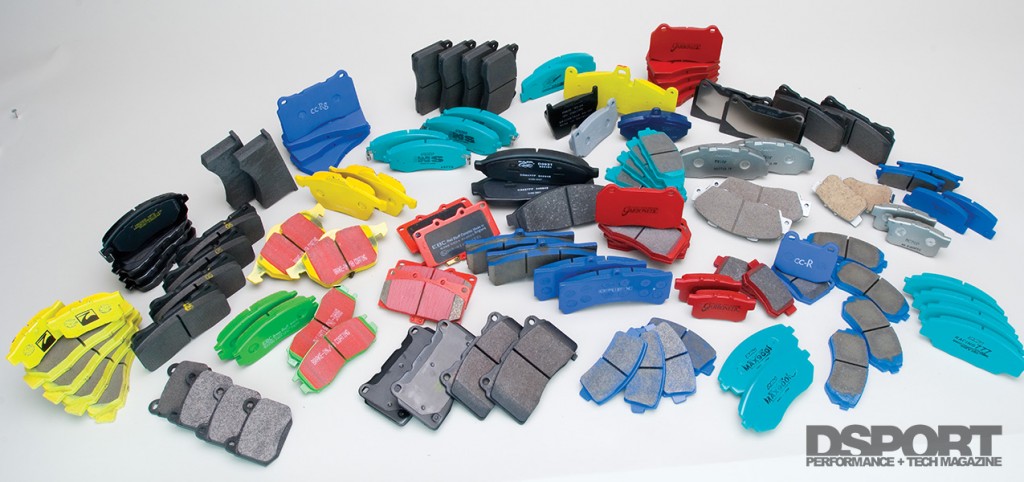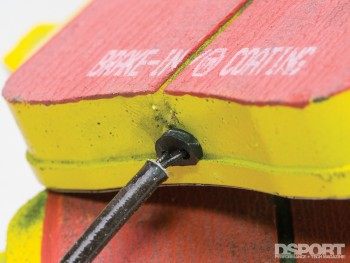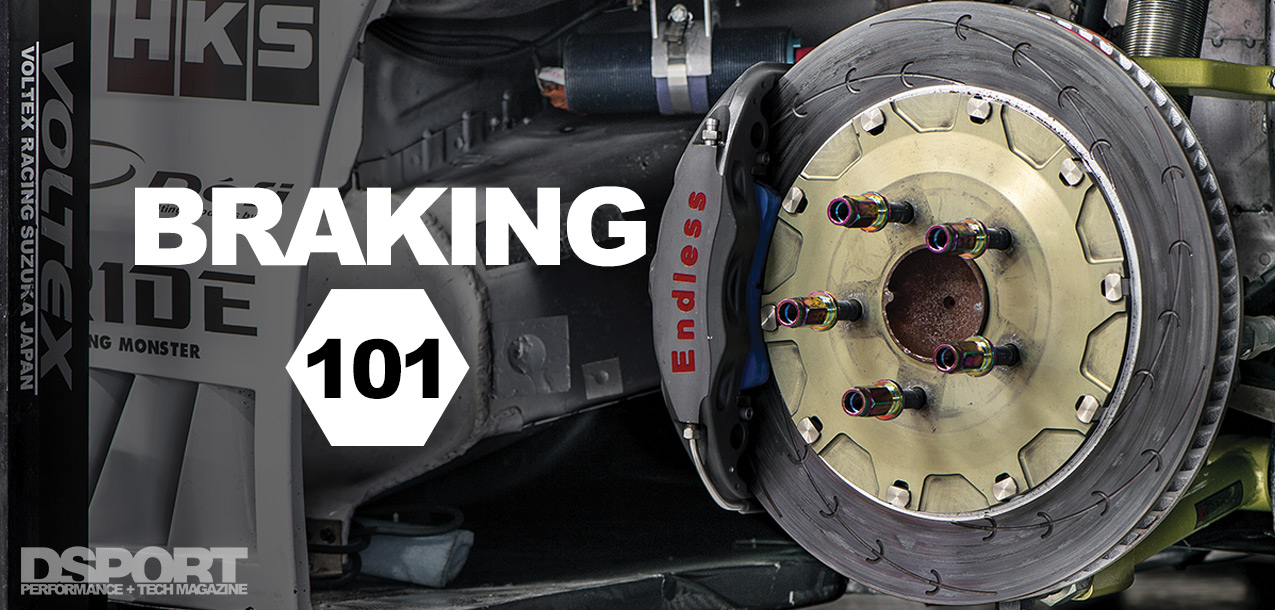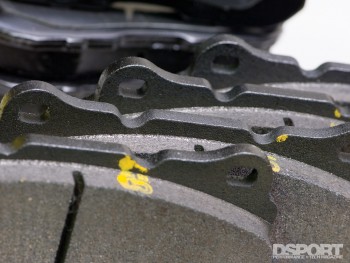The Friction: Pads
The brake pads work with the rotors to perform the actual conversion of kinetic energy into heat. When the brakes are applied, the hydraulic system forces the pistons in the calipers to squeeze the brake pads against the rotors. Friction between the pads and rotors causes heat to be generated. When all of the kinetic energy from the vehicle in motion is converted into heat, the vehicle will come to a stop.
The original-equipment brake pads on your vehicle are engineered with many compromises. In most cases, the compound is designed to provide exceptional cold- braking performance, good modulation, long pad life, long rotor life, low noise and low-dust production at a low cost to the vehicle manufacturer. For normal everyday driving, this type of compound provides adequate performance. With spirited driving or a trip to your local road course, the limitations of the factory compound become apparent. With OEM pads, hot-braking performance is marginal and brake fade can be experienced.
Performance brake pad manufacturers have a number of different friction materials at their disposal. There is no one friction material that will provide the ultimate in performance for all applications. Every brake pad compound makes a concession in one or more areas for an advantage in other performance areas. Different friction materials will exhibit different cold braking, warm braking, hot braking, initial brake response, fade resistance, noise, brake dust, pad life and rotor wear. To choose the right pad, communicate your needs to the pad manufacturer. If you have a street car, you probably want quiet brakes, with good cold braking performance and extended pad life. It’s probably also important that the pads don’t cause unacceptable rotor wear. For a racing application, you may just want pads that maximize the stopping power. Excessive noise, pad wear and decreased rotor life may be acceptable in that instance.
High-performance “street” pads should be able to deliver all the positive aspects of the original-equipment pad while offering significant improvements in resistance to brake fade. This is generally accomplished by using materials in the brake pad compound that are more expensive than the materials used in the OEM brake pad. Some aftermarket “street” brake pads may also reduce dust production.
“Racing” brake pads will generally provide significantly improved high-temperature braking performance and fade resistance. Since performance on the race track is the primary concern in the design of racing brake pads, it is not uncommon for these pads to deliver reduced pad life, reduced rotor life, increased dust production and increased noise.
Brake pad compounds come in a variety of types. The goal is to find the best compound for your vehicle and its intended use.
The materials and manufacturing processes that are used to make the brake compound ultimately determine the performance characteristics of the brake pad. Some of the friction materials used in brake pads are quite similar to the compounds used in clutch discs while other materials are unique to brake pads. The list of materials includes aramid fibers (Kevlar), sintered iron, carbon, ceramics, graphite, bronze, silicon, titanium and others. Brake pads are generally manufactured from a blend of different materials that deliver the desired performance characteristics. As a result, the brake-pad composition will generally be classified as organic (non- metallic), semi-metallic, sintered-metallic, ceramic-composite, carbon-composite or carbon-metallic composite. Since the material makeup of each compound is generally different from each brake-pad manufacturer, not all types of pads in the same class will have similar performance characteristics. Before choosing a brake pad for your application, be sure to read all of the provided information from the manufacturer on that particular compound. If you have questions, ask the company’s tech department before you make a purchase.
Depending on the type of driving, the operating temperatures of the brake pad and rotor will vary. Some companies offer special paints that can be applied to the edge of the rotor to determine the range of temperatures encountered. By knowing the ballpark of temperatures experienced, you should be better able to select the best brake pad for the job.
Since the coefficient of friction for different materials will vary based on the operation temperature, it’s important that you stay within the proper operating-temperature window for best performance. Failure to do so can result in a braking system that is unpredictable or unsafe.
Break-In/Bedding for Brake Pads
 Different pad compounds may require slightly different break-in procedures. Always follow the manufacturer’s recommended procedure. Some pad manufacturers recommend that you avoid bedding (breaking-in) a new set of performance pads on a brand-new rotor. Since the metal in a brand-new rotor is often “green” (never heat cycled), it’s sometimes too soft and excessive rotor wear can occur if bedding is done on a brand-new rotor. One solution sometimes used is to first heat cycle the new rotor on a set of factory pads.
Different pad compounds may require slightly different break-in procedures. Always follow the manufacturer’s recommended procedure. Some pad manufacturers recommend that you avoid bedding (breaking-in) a new set of performance pads on a brand-new rotor. Since the metal in a brand-new rotor is often “green” (never heat cycled), it’s sometimes too soft and excessive rotor wear can occur if bedding is done on a brand-new rotor. One solution sometimes used is to first heat cycle the new rotor on a set of factory pads.
While some brake pads are ready for racing out of the box, the performance of any brake pad will always improve after some bedding time. In most cases, desired bedding temperature is similar to the pad’s operating temperature range. Once the bedding operation is complete, allow the rotor and pads to naturally cool down to ambient temperature. At this point, your braking system should be ready to rock.




